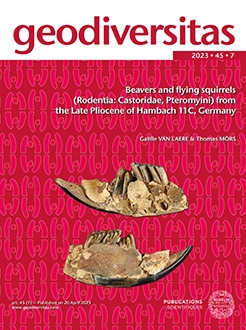This paper is a study of part of the rodent fauna collected at Hambach 11C, located in the Hambach lignite mine in north-western Germany. The deposits exposed here are fluvial channel fills of Late Pliocene age (MN16a) and the rodent material is compared to previously published material from the contemporaneous deposits of Hambach 11. Four species are discussed: two Castoridae, Castor fiber Linnaeus, 1758 and Trogontherium minus Newton, 1890 and two Sciuridae, Blackia miocaenica Mein, 1970 and Pliopetaurista pliocaenica Depéret, 1897. This new material is of great importance as the fossil records of T. minus and B. miocaenica are very scarce so far. Blackia is especially rare in the Late Pliocene and this occurrence is one of the three youngest of the genus. We also described the most complete juvenile material of Trogontherium minus. The fauna is indicative of fluvial environment surrounded by a forest of deciduous trees and of a temperate and humid climate.
Castors et écureuils volants (Rodentia: Castoridae, Pteromyini)du Pliocène supérieur d'Hambach11C, Allemagne.
Cette étude concerne une partie de la faune de rongeurs trouvés dans la couche Hambach 11C, de la mine de lignite d'Hambach située dans le nord-ouest de l'Allemagne. Ces affleurements de dépôts fluviatiles sont datés du Pliocène supérieur. Le matériel étudié est comparé à d'autres spécimens d'âges contemporains précédemment publiés et provenant d'Hambach 11. Quatre espèces sont traitées ici: deux Castoridae, Castor fiber Linnaeus, 1758 et Trogontherium minus Newton, 1890 et deux Sciuridae, Blackia miocaenica Mein, 1970 et Pliopetaurista pliocaenica Depéret, 1897. Ce nouveau matériel est d'une grande importance du fait de la rareté des fossiles de T. minus et de B. miocaenica. Blackia est particulièrement rare dans le Pliocène supérieur et le présent spécimen est l'un des plus récents du genre. Nous présentons également le matériel juvénile le plus complet à ce jour de Trogontherium minus. La faune indique un environnement fluviatile entouré d'une forêt de feuillus et d'un climat humide et tempéré.





